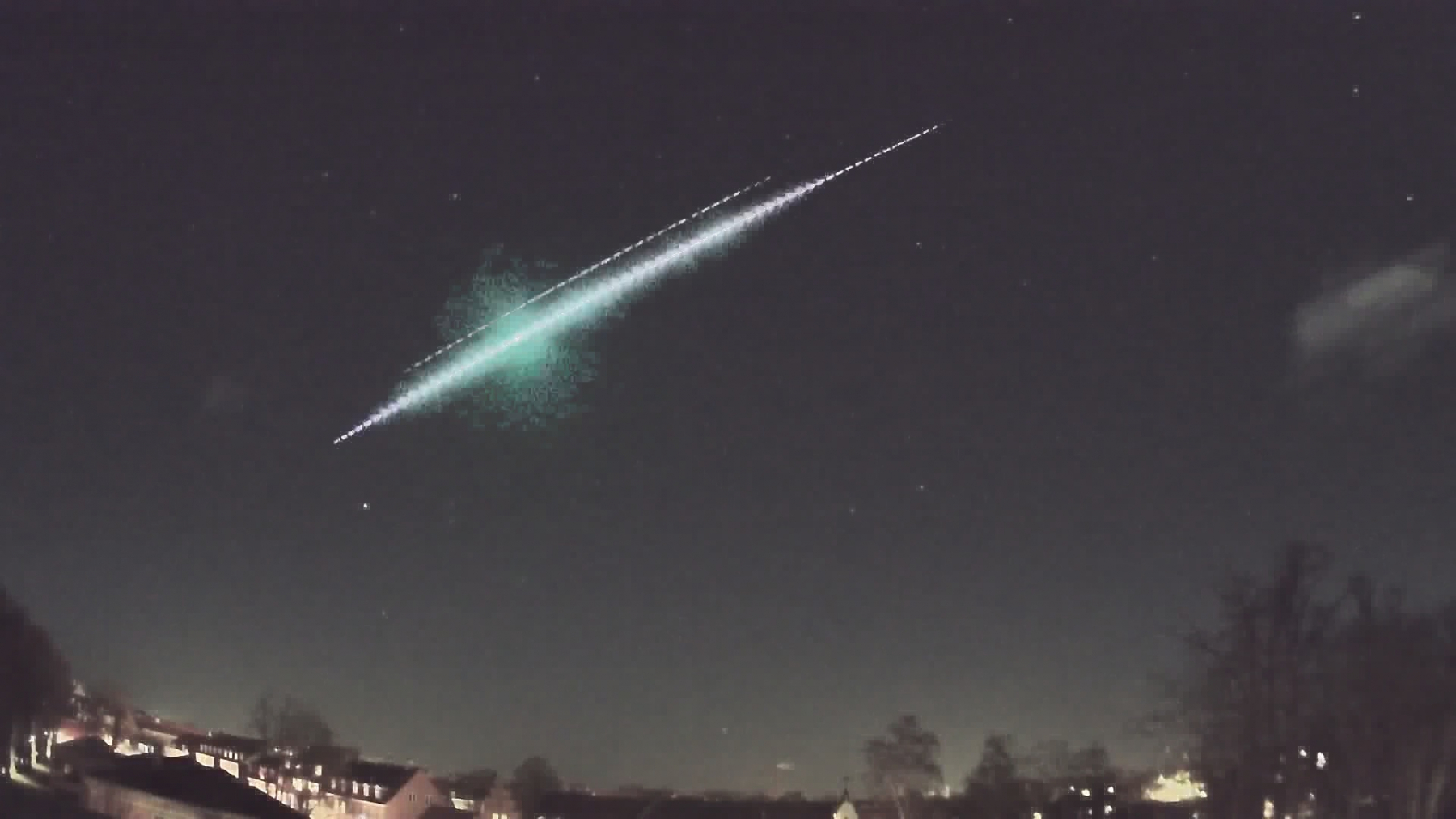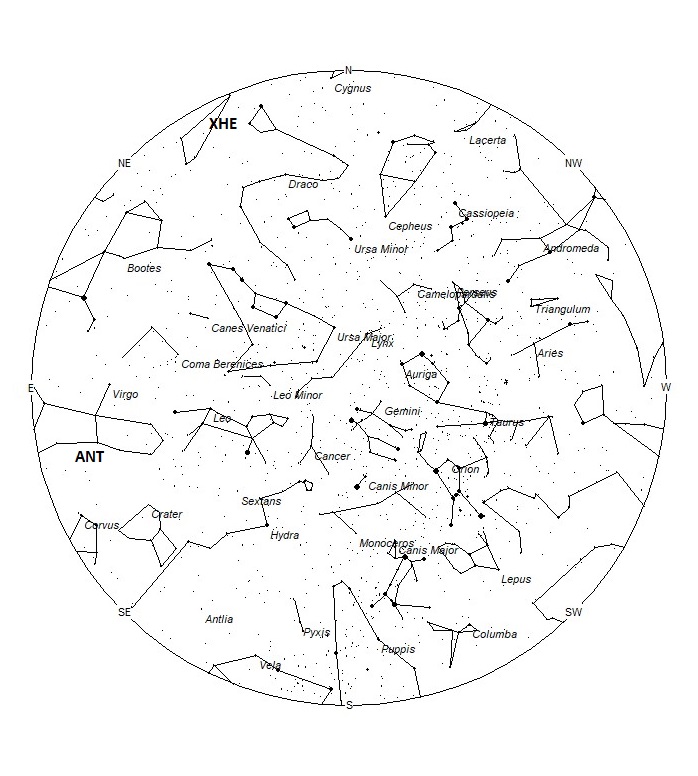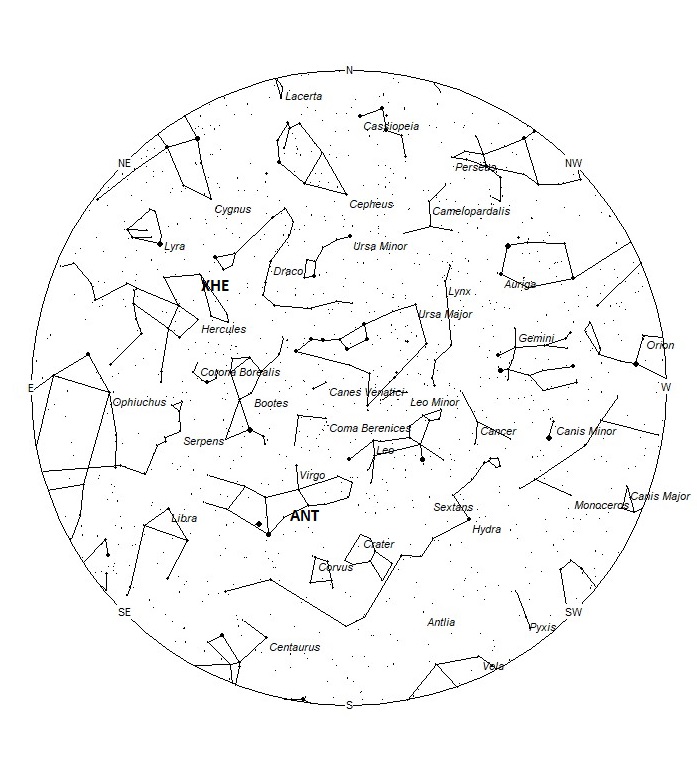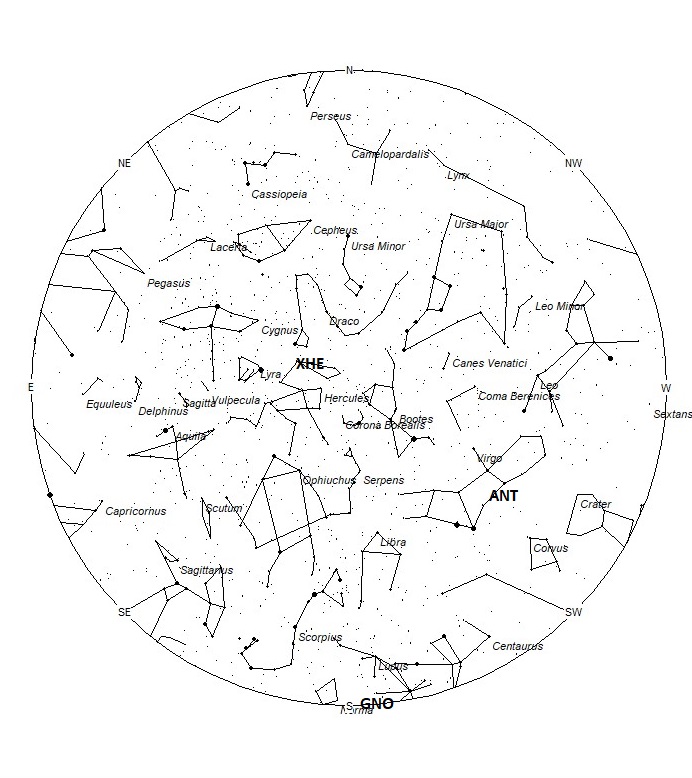 Henning Haack captured this brilliant fireball using his AllSky7 Camera System on January 19, 2022 at 22:34 CET (21:34 UT) from Sorø, Denmark. The secondary dashed streak above the main fireball is an artifact. ©Henning Haack
Henning Haack captured this brilliant fireball using his AllSky7 Camera System on January 19, 2022 at 22:34 CET (21:34 UT) from Sorø, Denmark. The secondary dashed streak above the main fireball is an artifact. ©Henning HaackDuring this period, the moon wanes from nearly full to nearly half-illuminated by the end of the week. This is the worse time of the month to try and observe meteor activity as the bright moon will lie above the horizon most of the night and will obscure all but the brightest meteors. For evening observers, the estimated total hourly rates should be near 1 as seen from mid-northern latitudes (45N) and 2as seen from tropical southern locations (25S) For morning observers, the estimated total hourly rates should be near 3 as seen from mid-northern latitudes (45N) and 5 as seen from tropical southern locations (25S). The actual rates will also depend on factors such as personal light and motion perception, local weather conditions, alertness, and experience in watching meteor activity. Rates are reduced during this period due to moonlight. Note that the hourly rates listed below are estimates as viewed from dark sky sites away from urban light sources. Observers viewing from urban areas will see less activity as only the brighter meteors will be visible from such locations.
The radiant (the area of the sky where meteors appear to shoot from) positions and rates listed below are exact for Saturday night/Sunday morning March 19/20. These positions do not change greatly day to day so the listed coordinates may be used during this entire period. Most star atlases (available at science stores and planetariums) will provide maps with grid lines of the celestial coordinates so that you may find out exactly where these positions are located in the sky. I have also included charts of the sky that display the radiant positions for evening, midnight, and morning. The center of each chart is the sky directly overhead at the appropriate hour. These charts are oriented for facing south but can be used for any direction by rotating the charts to the desired direction. A planisphere or computer planetarium program is also useful in showing the sky at any time of night on any date of the year. Activity from each radiant is best seen when it is positioned highest in the sky, either due north or south along the meridian, depending on your latitude. It must be remembered that meteor activity is rarely seen at the radiant position. Rather they shoot outwards from the radiant, so it is best to center your field of view so that the radiant lies at the edge and not the center. Viewing there will allow you to easily trace the path of each meteor back to the radiant (if it is a shower member) or in another direction if it is sporadic. Meteor activity is not seen from radiants that are located far below the horizon. The positions below are listed in a west to east manner in order of right ascension (celestial longitude). The positions listed first are located further west therefore are accessible earlier in the night while those listed further down the list rise later in the night.
These sources of meteoric activity are expected to be active this week.
Details of each source will resume next week when viewing conditions are more favorable.
You can keep track of the activity of these meteor showers as well as those beyond the limits of visual observing by visiting the NASA Meteor Shower Portal available at: https://meteorshowers.seti.org/ You can move the sky globe to see different areas of the sky. Colored dots indicate shower meteors while white dots indicate sporadic (random) activity. The large orange disk indicates the position of the sun so little activity will be seen in that area of the sky.
| SHOWER | DATE OF MAXIMUM ACTIVITY | CELESTIAL POSITION | ENTRY VELOCITY | CULMINATION | HOURLY RATE | CLASS |
| RA (RA in Deg.) DEC | Km/Sec | Local Daylight Saving Time | North-South | |||
| delta Mensids (DME) | Mar 20 | 03:52 (058) -80 | 33 | 19:00 | <1 – <1 | III |
| beta Tucanids (BTU) | Mar 13 | 04:07 (062) -77 | 31 | 19:00 | <1 – <1 | III |
| Anthelions (ANT) | — | 12:48 (192) -05 | 30 | 02:00 | 1 – 1 | II |
| Gamma Normids (GNO) | Mar 24 | 15:35 (234) -54 | 56 | 05:00 | <1 – <1 | IV |
| xi Herculids (XHE) | Mar 12 | 17:27 (262) +47 | 34 | 07:00 | <1 – <1 | IV |
| Delta Pavonids (DPV) | Mar 31 | 19:22 (279) -61 | 58 | 09:00 | <1 – <1 | III |
 American Meteor Society
American Meteor Society



Sawa slower moving intense large ball of fire (greenish in color) this AM around 4-4:15AM from West to East over Parker county. Was the largest “meteor” I have ever seen.
Last night around 1:15am MDT, I witnessed a huge meteor streak low across the sky (west to east) in Blaine County, ID. It was significantly bigger, brighter and slower moving than any other I have ever seen. Just before it burned out, it seemed to explode with green, yellow and blue color. I fully expected to hear something crash into the earth, but did not.